11 Awesome Then & Now Photos of Metro Manila
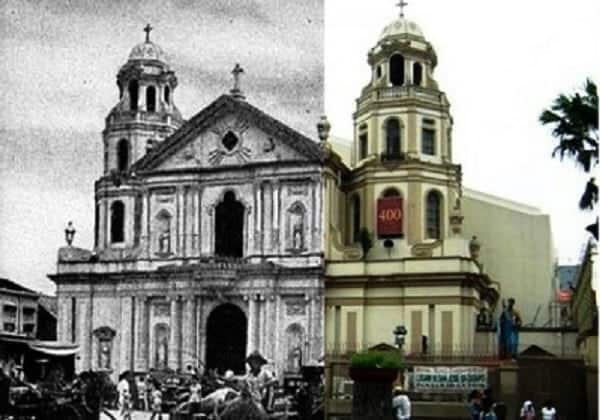
We can never turn back time but if it’s any consolation to us, there are vintage photos of Manila that we can still look at to relive the city’s glorious past.
Most “then and now” photos, unfortunately, show how Manila has been ruined by pollution, modernization, and some Filipinos’ lack of appreciation for historical landmarks. Although change is the only constant thing in the world, it is imperative for everyone to look back, appreciate our history, and move forward with the lessons from the past instilled in our hearts.
Also Read: The Oldest Known Photos of the Philippines Ever Taken
Below are 11 side-by-side comparisons showing how Manila has evolved throughout the decades. May this simple list remind us that we can still look forward to the future without forgetting our past.
1. Plaza Moraga, Binondo, Manila
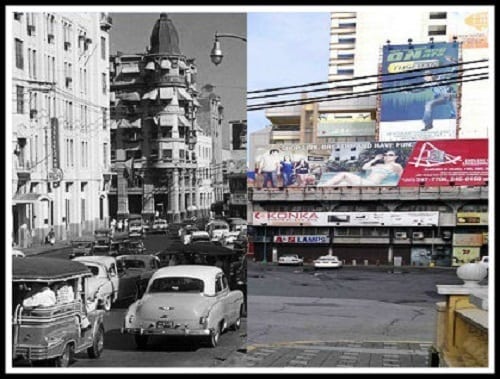
Plaza Moraga is where the famous street of Escolta is located. It was also the site of the first ice cream parlor in the Philippines, Clarke’s Ice Cream.
Named after its owner, M.A. Clarke, the store was a candy shop, café, soda fountain, and ice cream parlor rolled into one. Read More: 10 Fascinating Firsts in Philippine History
2. Monte De Piedad Building (now Prudential Bank Building)

This building in front of Sta Cruz Church housed the very first bank in the Philippines. Established by a Franciscan priest named Fr. Feliz Huertas, the Monte Piedad (“Mountain of Mercy”) Savings Bank served as a pawnshop for the people during its early days.
The bank was originally located inside the Intramuros but was later transferred in 1894 to Monte Piedad Building (now Prudential Bank Building) in Plaza Goiti (now Plaza Lacson).
3. Life Theater (now Villonco Building)
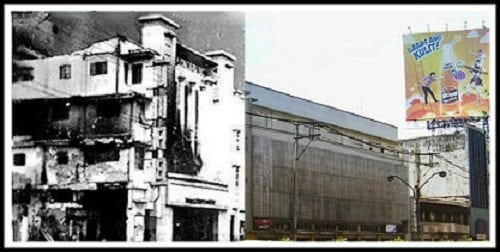
Located along Quezon Boulevard in Quiapo, Manila, the Life Theater was one of the top theaters in the city during the 1950s. The building was designed by National Artist Pablo Antonio and could accommodate a total of 800 people. The theater eventually closed its operations, was renamed as the Villonco Building and is now a shopping center.
4. Calle Rosario, Binondo (now Quintin Paredes Street)
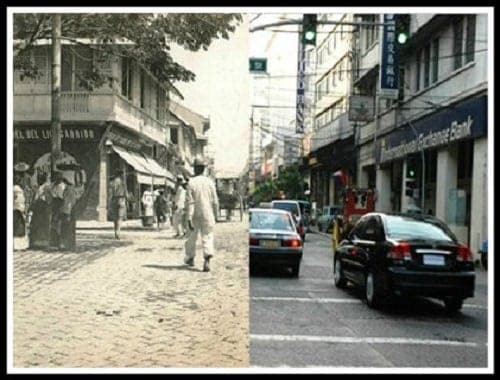
Quintin Paredes Street was formerly known as Calle Rosario after the district’s patron saint. It was later renamed after a Filipino lawyer and statesman Quintin Paredes who became both a legislator for Abra and Speaker of the House.
5. Quiapo Church (Minor Basilica of the Black Nazarene)
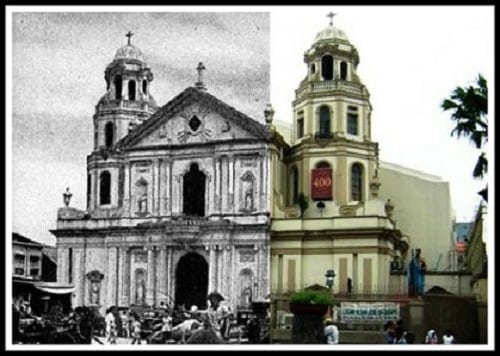
Also known as St. John the Baptist Parish, Quiapo Church is a Roman Catholic church that is home to the famous Black Nazarene. It was burned down in 1928 but was later rebuilt and painted cream. To accommodate a growing number of devotees, the church was expanded to its current form in 1984.
6. San Sebastian Church, Quiapo, Manila
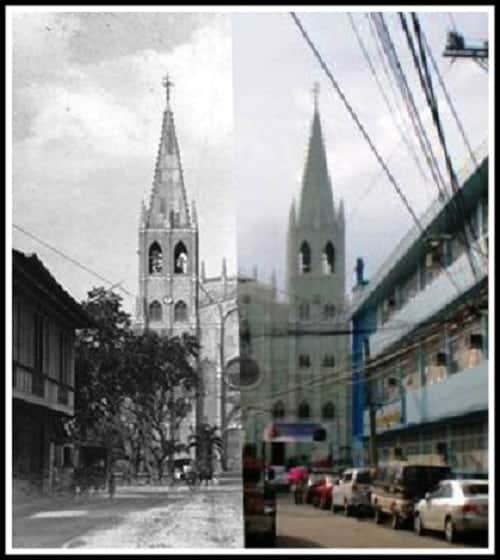
Also known as the Basilica Minore de San Sebastian, the San Sebastian Church is the only steel church in Asia. Built in 1891, it was declared a National Historical Landmark in 1973.
7. Plaza de Roma, Intramuros, Manila
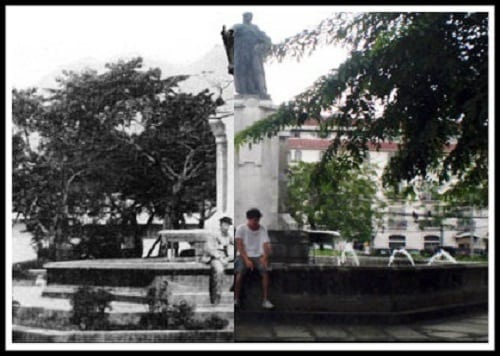
Plaza de Roma is one of the two major public squares in Intramuros (the other one being Plaza de Armas). During the Spanish colonial era, it was considered the center of the city until it was converted into a garden in 1797 by then Governor-General Rafael Maria de Aguilar.
The plaza earned its current name in 1961 when Rufino Santos became the first Filipino cardinal. It is surrounded by three important landmarks namely the Manila Cathedral (south), Ayuntamiento de Manila (east), and the Palacio del Gobernador (west).
8. San Agustin Church, Intramuros, Manila
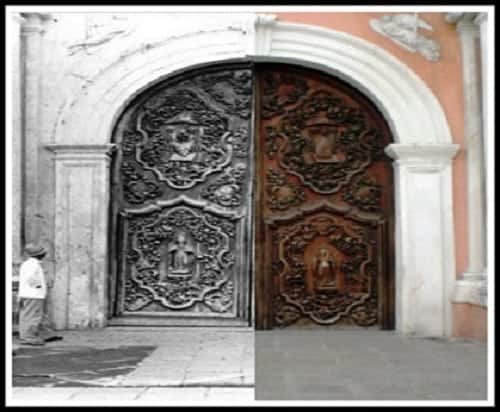
San Agustin Chruch in Intramuros is a Roman Catholic church that was one of the four Philippine churches designated by UNESCO as a World Heritage Site in 1993.
The present-day structure is already the third church erected on the site. The first one was destroyed by fire in 1574 when the forces of Limahong attempted to invade Manila. The second structure was also destroyed in 1583 after a fire accident that happened during the internment of Governor-General Gonzalo Ronquillo de Peñalosa.
9. Binondo Church, Binondo, Manila
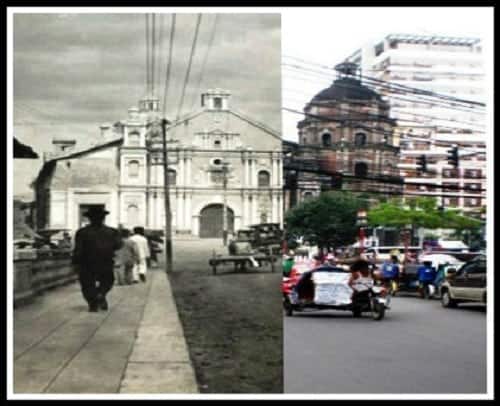
Founded in 1596 by Dominican priests, Binondo Church is also known as the Minor Basilica of St. Lorenzo Ruiz, after the country’s first official saint. The original building was destroyed in 1762 after the British forces bombarded the place. It was later replaced by a granite church in 1852 but the latter was also damaged during WWII, leaving only the western facade and the octagonal bell tower intact.
10. Manila Cathedral, Intramuros Manila
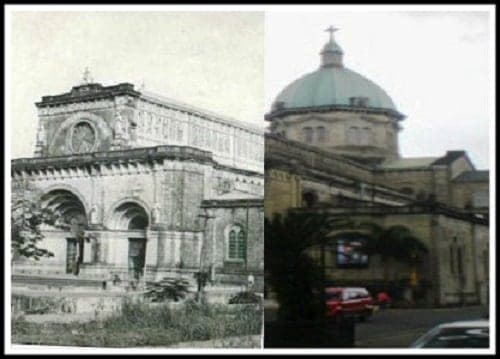
Originally owned by the diocese of Mexico, the Manila Metropolitan Cathedral-Basilica, or simply Manila Cathedral, was built to honor the Blessed Virgin Mary as Our Lady of the Immaculate Conception.
The church, which serves as the highest seat of Archbishop in the country, has survived several earthquakes and damages since it was first established in 1581. Its present-day structure was completed in 1958 and was then consecrated as a minor basilica in 1981.
11. Calle Real del Palacio (now General Luna Street)
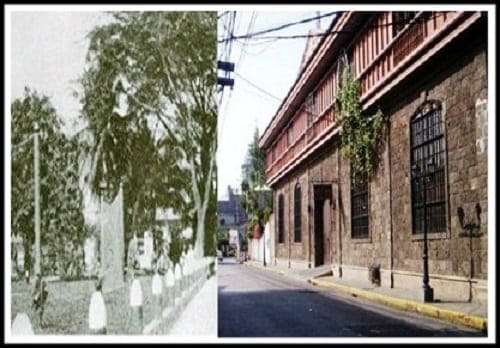
General Luna Street, formerly known as the Calle Real del Palacio is the visitor’s pathway towards the major attractions that Intramuros has to offer, including the Manila Cathedral, Fort Santiago, Rizal Park, and San Agustin Church among others.
Also Read:
10 Vintage Photos of Filipinos Being Awesome
10 Fascinating Pinoy Vintage Photos on Amazon.com
7 Creepiest Photos from Philippine History
20 Remarkable Colorized Photos Will Let You Relive Philippine History
FilipiKnow
FilipiKnow strives to ensure each article published on this website is as accurate and reliable as possible. We invite you, our reader, to take part in our mission to provide free, high-quality information for every Juan. If you think this article needs improvement, or if you have suggestions on how we can better achieve our goals, let us know by sending a message to admin at filipiknow dot net
Copyright Notice
All materials contained on this site are protected by the Republic of the Philippines copyright law and may not be reproduced, distributed, transmitted, displayed, published, or broadcast without the prior written permission of filipiknow.net or in the case of third party materials, the owner of that content. You may not alter or remove any trademark, copyright, or other notice from copies of the content. Be warned that we have already reported and helped terminate several websites and YouTube channels for blatantly stealing our content. If you wish to use filipiknow.net content for commercial purposes, such as for content syndication, etc., please contact us at legal(at)filipiknow(dot)net